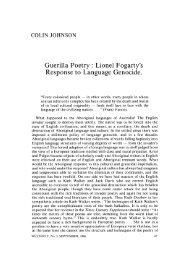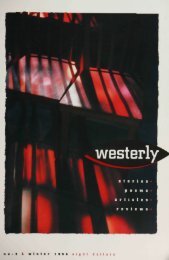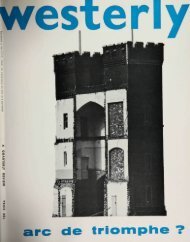You also want an ePaper? Increase the reach of your titles
YUMPU automatically turns print PDFs into web optimized ePapers that Google loves.
1946 (both reproduced in Art & Australia,Sept. 1967), with 'Agricultural Hotel', appearsto me to make it clear that there has been aconsiderable diminution in the intensity of perceptionand the actual handling of the paintitself. On the one hand we have illumination,and on the other something which relates, atleast in part, to illustration. It had not occurredto me before, but in seeing these 1948 paintingsas a group, I felt that at that time Nolan couldwell have been influenced by some of Drysdale'searly outback paintings. There is certainlya remarkable common denominatorbetween them, though it is rather as if Nolanhad treated somewhat lightly and with a senseof humour what Drysdale had painstakinglyrepresented. In any event, the paint surfacehas become suave rather than felt, and onesenses a loss of creative involvement- which is,in fact, carried through into the Central Australianpaintings. It is difficult not to be impressedwith these latter paintings, specially ifthey are seen massed together as they were intheir original showing at David Jones Galleryin Sydney in 1950. It is not that they are bigin size—though big enough for the time whenthey were painted—but, being painted from abirdseye view (actually, I believe, from photostaken in a plane) they present such a vastimage of the inland that one almost feels thatthe paintings themselves are vast. Once again,however, one senses a lack of commitment inthe artist: it is as though he is painting brilliantlyand rather coldly what the outer eye seesso clearly on the surface; but his inner eye,which reveals meaning, remains closed.Without a very much more complete acquaintancewith his work than even this exhibitiongives, it would be dangerous to generalisetoo far; but it seems to me that it was not tillthe Leda and the Swan paintings of about 1958that Nolan's particular magic began to comeout again from beneath the surface of thepaintings. This was even more in evidence inhis 1962 series of inland paintings, such as'Deserted Township, Dawn', and 'Explorer andTownship', both of which are painted with atenderness and an understanding which is quitebreathtaking.It is rather silly to talk of an artist's 'best'paintings—he probably paints all sorts of different'best' paintings—but in an assessment ofNolan's work we must at least note his Africanpaintings as being among his most remarkable.When I first saw them at Kym Bonython'sgallery in Adelaide in 1964 I had a tremendoussense of Nolan's beautiful vision (so aptlynoted by James Gleeson in his review of thisshow); how he had seen some astoundingphenomenon, the phenomenon of wild Africa,for the first time, and had apprehended itwithin himself perfectly, and as no one hadever done before; but then I felt, that in realisingthis in his paintings, it had somehow justeluded him: you could sense the urgency withwhich they had been painted and their completeintegrity, but you wondered whether therewas still something more to be said in orderto make them quite complete paintings. Now,with the passage of time, and seeing themagain, I am not so sure, and it seems to methat in paintings such as 'Elephant and Mountain'(reproduced in colour in the catalogue)and 'Elephant and Tree', he has achieved analmost perfect realisation of his vision. Thisis not just brilliance—in fact, if there is afailure it is in the area where brilliance operates—itis something much more fundamental:it is the same thing which one finds in the firstKelly series, and in this sense it is interestingto compare them. To me the Kellys still seemmore fully reaUsed as a series than the Africanpaintings; but I am ready to admit that thismay be because I have lived with them for20 years, and it is more than possible that Ihave not yet caught up with Nolan's achievementin these later ones.Again, in the Antarctic paintings we see thissame quality; but, after the African paintingsit is only a glimpse and not the full blaze ofillumination which they reveal to us. We see itmost clearly in 'Mt. Erebus' and in 'AntarcticExplorer', with its amazing patch of green onthe horse and figure.The finale of the exhibition is the series of3 panels, each 60" x 432", 'Riverbend', 'Glenrowan'and 'Inferno'. 'Riverbend' (reproducedin colour on the cover) presents an endlessstretch of river, an endless wall of river gumsbehind it and some small figures (includingKelly) in the shallows. As a subject, even aphilosophy, this seems to present great potentialitiesfor Nolan; but- as far as I am concerned,it is something I apprehended intellectually,not pictorially. For me, the paintingdoes not yield up its secrets, and I am leftwith thoughts of what might have been. Ihave faith in the truth of Nolan's vision, but38 WESTERLY, No. 1, MARCH, 1968







